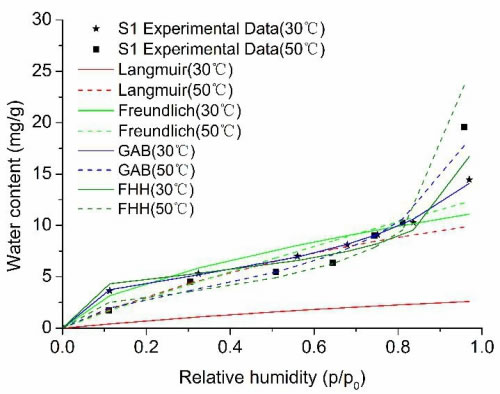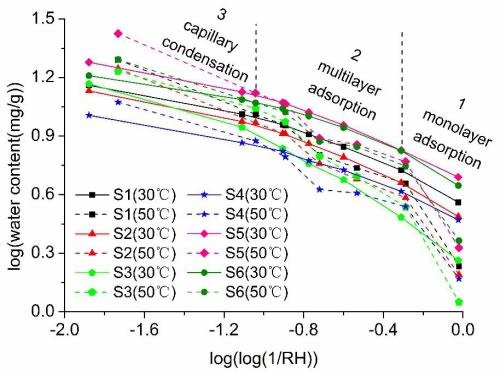In the context of the increasing demand for oil and gas resources in the world economy, the development and utilization of unconventional shale gas resources have received much attention. Shale gas reservoirs have unique storage and low permeability features. Horizontal well completion and hydraulic fracturing technologies are key technologies for the development of shale gas reservoirs. However, in the hydraulic fracturing process, only a small part of the fracturing fluid is recovered in the cleaning stage, and most of the fracturing fluid is retained in the shale formation. The water lock problem seriously affects the effective development of the shale gas reservoir. The study of the gas-water flow mechanism in shale gas reservoirs has important theoretical significance for the efficient development of shale gas reservoirs. In recent years, researchers from the Institute of Mechanics, Chinese Academy of Sciences, China Petroleum Exploration and Development Institute, and the Lawrence Berkeley National Laboratory have collaborated to make series of progresses in the gas-water flow mechanism of shale gas reservoirs. The researchers designed a shale water adsorption and desorption device, and studied the characteristics of water adsorption, desorption and infiltration of shale, revealed the mechanism of adsorption, desorption and adsorption of shale water, and established a numerical model for adsorption and diffusion of shale water. The results show that the water adsorption in shale is closely related to organic carbon content and mineral composition. The GAB isothermal model can describe and predict its adsorption process, while the FHH curve can be used to distinguish the boundary state of the adsorbed water; the water adsorption and desorption of shale is serious. Hysteresis occurs when water with a capillary force of up to 1 MPa can be driven out of the shale. The water lock problem severely restricts the effective development of the shale gas reservoir. The output of shale gas is mainly related to the fracturing zone that is not in contact with the fracturing fluid. closely related. Based on the Knudsen number, the researchers divided flow patterns at different scales of shale gas, analyzed the characteristics and influencing factors of gas flow under each flow mode, and based on the dust gas model and the generalized Langmuir model. (Extended Langmuir Model), using the TOUGH2 simulation program to study the diffusion and adsorption processes of shale gas, and analyze the influence of pressure, temperature, and permeability changes on the diffusion and adsorption of shale gas. The results show that the pressure change has a great influence on the proportion of each flow state and the temperature has almost no influence on it. The adsorption affects the total mass flux of shale gas. The dust gas model is more suitable for describing the diffusion of medium in low permeability reservoirs. During the process, when the permeability is lower than 1.0×10-15 m2, the change of permeability has little effect on the diffusion and adsorption rate of shale gas. The above research results have important theoretical significance for the diffusion and adsorption flow, productivity evaluation and fracturing design of shale gas reservoirs. Related research results have been published on Water Resources Research, Energies, Transport in Porous Media, Journal of Natural Gas Science and Engineering, and the like. The study was conducted by the U.S. Department of Energy, the 12th Five-Year Plan, and the 13th Five-Year Plan National Major Oil & Gas Project, the China Scholarship Fund, the China Petroleum Exploration and Development Research Institute, and the Young Scientists Fund of the Fluid-Structure Coupling Key Laboratory of the Chinese Academy of Sciences. Funding.
Sectional Door Accessories: motor 220V-380V, control box, spring break device, cable break device , aluminum alloy rope pulley, enhanced shaft bracket, air bag system, duplex enhanced guide wheel bracket.
Detail introduction for above main accessories
1.Motor and controller:
The garage door operator is designed for residential overhead sectional and tilt doors.
The operator memorizes the limit positions and unique braking system that slows the unit down at the end of its travel.
Rolling code remote control with max. 20 pcs hand transmitters.
The operator is equipped with a manual release lever which allows manual operation of the door in case of power failure.
The controller has a security LOCK function which prevents operation of the door from transmitter.
2.spring break device:
Sectional doors are hinged and they bend in the tracks as the door opens and closes. Many of these doors are counterbalanced with extension springs, also designated "stretch springs," and they have seven characteristics. The length is the measurement of all the coils pressed together. This, along with the inside diameter of the coils and wire size - the thickness of the wire from which the springs are made - determine the stretch, the distance the spring is extended - normally half the door height, and pull, the force the spring pulls when stretched its normal length. The type of ends determine how the ends of the spring are mounted. The initial tension is the percentage of pull needed to separate the coils. This is determined by the pitch with which the springs are wound. On sectional garage door springs this is normally 15 percent. For example a 100 pound pull spring requires 15 pounds of weight to separate the coils; when a door is open the two springs will support 15 pounds of door weight without any stretch.
Most extension springs are made of oil tempered wire. These are normally coated or painted. Some springs are made of galvanized wire.
3.able break device:
cable break device ,door hardware
adjustable bottom bracket .
the raw material hot plate
zinc plated
safety device
adjustable bottom bracket
the raw material hot plate
zinc plating
spring safety device ,2" and 3" safety device
once the cable is broken ,this devoice can keep the hurt away from the door falling
4.aluminum alloy rope pulley
Equipment: CNC stamping/punching machine, CNC bending machine, CNC cutting
machine, 5~250 tons punching machines, welding machine, polish machines...
Processed material: stainless steel: copper, carbon steel
Surface treatment: Hot galvanized, polishing
Making process:Stamping, deep drawing,bending, punching, laser cutting,threading,
welding, tapping, riveting, grinding
5.air bag system
It is a safety device. When the door is down to hit something, it will up automatically.
Operation pressure:<3mbar
Battery:CR2032*2
Battery lifetime>1 year
Emission frequency: 315MHZ
Emission power:<10mW
Receiver power source:12V
6.duplex enhanced guide wheel bracket
Determining the right type of sectional door roller for your garage door tracks can be a little confusing, especially when you do not know what you need to look for in a garage door roller. To simplify things, there are two primary things you need to be aware of. First are the actual dimensions of the roller, and second is purpose that you will be using the door for. You can read below about measuring your roller and choosing the right quality of material for your door.
Other Door Accessories,Electronic Door Accessories,Automatic Door Accessories,High Speed Door Radar Detector Shenzhen Hongfa Automatic Door Co., Ltd. , https://www.selfrepairinghighspeeddoor.com
Figure 1. Fitting of adsorption model and experimental data 
Figure 2. FHH curve determines the bound state of adsorbed water